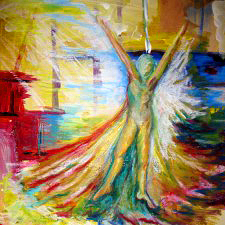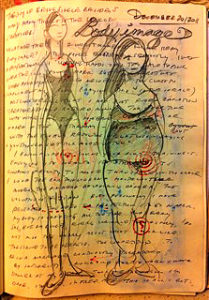Negative Body Image
Art Therapy and Intermodal Techniques

Re-examine your body image through art.
A former client “Regina” (pseudonym) was uncomfortable with her body, hated shopping for clothes, saw her body differently than other people saw it, frequently compared herself and her body to others, and suffered from self-judgments. As a result, she often thought, “I am fat,” and “I am disgusting.” Can you relate to Regina’s struggles? If so, you or a person you know might benefit from re-examining your body image. Negative body image is not often openly discussed, but it’s an epidemic in the United States affecting men, women, and transgendered individuals. As an example, A.E. Anderson’s research found that “men are dissatisfied from the waist up, and women, from the waist down.” Even though the national incidence of Eating Disorders might seems low at 1-3% of population, 40% of the population is trying to lose weight, suggesting a preoccupation with physical appearance, particularly body size. One glance at print media and you are bombarded with less-than-reality, “photoshopped” bodies next to ads promising weight loss, enhanced performance and instant body size and shape change. Body dissatisfaction can be just as likely to lead you to social anxiety, depressed mood, and sexual difficulties; not just disordered eating.
Are you looking for art therapy to help relief your struggle? Contact us today to make an appointment.
Art Therapy and other creative-expressive modalities (i.e., poetry, movement & dance) can improve body satisfaction, self-confidence, and self-image/identity. Art Therapy is not just an adjunct to psychotherapy but a modality in and of itself. Creative modalities can focus on helping clients understand origins of negative body image, how they are affected by it, and creating alternate views of themselves. Some creative-expressive interventions can be helpful as self-guided experientials.
Here are a few ideas you can try at home:
- Use writing to focus on neutral or likable attributes of body, such as writing a poem in the spirit of “Homage to my Hips,” by Lucille Clifton.
- Focus on non-physical aspects of self and personality: take an old deck of playing cards and see how many cards you can turn into mini-collages representing various aspects of yourself (i.e., 1 card about musical talents, 1 card about being a parent, 1 card about ways that you are a caring person, etc.).
- Keep a “creative journal” to record fluctuations in body image, patterns of feelings about one’s body and one’s self-image, and witness change and growth. Creative journaling is best done in an unlined bound notebook where you can keep paintings, writings, doodles, etc., dated and in chronological order.

Reveal inner thoughts about outer views through drawing.
If you find these experientials to be helpful by increasing positive thoughts and feelings about yourself and your body, art therapy could be a great fit for you! With a trained, experienced Art Therapist as your guide, more complex creative interventions and deeper processing can take place in a safe, private environment. They would help facilitate the creation of art products, followed by verbal & written processing such as examining your emotional reactions to the images created; and identifying themes and values displayed in the art, such as perfectionism, self-denigration, shame, anxiety, modesty, respect, grace, self-expression, and/or confidence. Processing such as this can also help the client identify personal goals for treatment.
Contact New Directions Counseling Services for more information on Art Therapy and our therapists whom can nurture this process with you.
written by Lauren Cormier, MAAT, LPC
